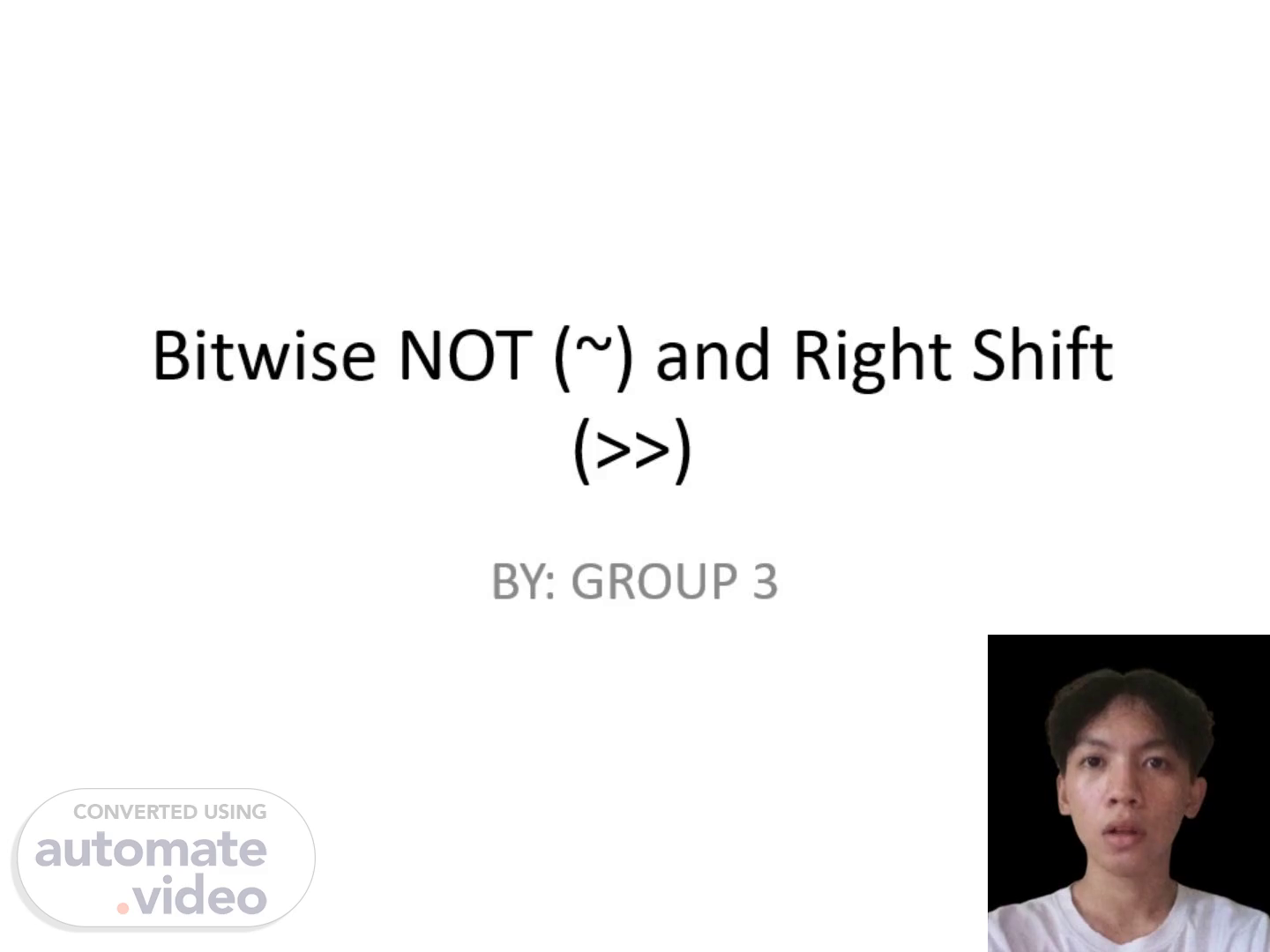Scene 1 (0s)
Bitwise NOT (~) and Right Shift (>>). BY: GROUP 3.
Scene 2 (42s)
[Audio] This slide is focused on the Bitwise NOT (~) and Right Shift (>>) operators and their applications in programming, optimization, and hardware tasks. These operators allow for manipulation of individual bits, providing more control and flexibility in coding. We will be discussing the utility of these two operators and their various applications. Firstly, the Bitwise NOT (~) operator, also known as the complement operator, converts 0 bits to 1 and 1 bits to 0, useful for binary number inversion and bit flipping. The Right Shift (>>) operator shifts bits to the right by a specified number, often used in division by powers of 2. Both operators offer unique benefits in improving coding efficiency and functionality. Throughout this presentation, we will further explore their potential applications..
Scene 3 (1m 37s)
[Audio] Today, we will discuss the Bitwise NOT operator, denoted by the tilde symbol (~). This operator flips every bit of a number, changing 1s to 0s and 0s to 1s. It is important to note that this operator is used for two’s complement representation of negative numbers in binary. Let's look at an example: if the variable "a" is assigned to the value 5, in binary it would be 00000101. Applying the Bitwise NOT operator to "a" and assigning the result to "b" would give us 11111010, which is -6 in decimal form. This operator is essential in computer programming for manipulating binary numbers. We will now move on to our next topic, the Right Shift operator..
Scene 4 (2m 33s)
[Audio] We will now move on to slide number four to discuss Bitwise NOT and Right Shift, two commonly used operations in programming that play a crucial role in determining the outcome of a program. Our focus will be on Bitwise NOT, which is denoted by the symbol '~' and also referred to as the complement operator. It takes one operand and flips all of its bits, essentially switching the 0's and 1's. To better understand this, we will refer to the Truth Table on the slide. As shown, when A is 0, ~A becomes 1, and when A is 1, ~A becomes 0. Let's take an example to see this in action: when we apply the Bitwise NOT operation to the binary number 0101, we get 1010. In decimal, this is equal to -6. It is important to note that the result of Bitwise NOT depends on the number of bits used to represent the number. Moving on, we will now discuss Right Shift. This operation uses the symbol '>>' and is used to shift the bits of a number to the right, essentially dividing the number by 2. On the next slide, we will explore how these operations can be applied in programming and how they can impact the program's outcome. Stay tuned as we move on to slide number five..
Scene 5 (3m 54s)
[Audio] This presentation covers the Bitwise NOT and Right Shift operators, their functions, and applications in programming. Slide number five will focus on the Right Shift operator (>>), which shifts the bits of a number to the right, dividing it by 2 with each shift. For example, if a variable 'a' has a value of 20 in binary (00010100), using the >> operator with a shift value of 2 results in 00000101, equivalent to the decimal value of 5. This operator is useful for dividing numbers by powers of 2, data compression and encryption algorithms. The Right Shift operator (>>) is a valuable tool in bitwise operations, allowing for more efficient manipulation of numbers. Now, let's move on to our final slide on Bitwise NOT..
Scene 6 (4m 48s)
[Audio] In slide 6, we will focus on the Bitwise NOT (~) and Right Shift (>>) operators, commonly used in computer programming to manipulate binary numbers. The table will show an example of the Right Shift operation. A, represented in binary as 1010, is equivalent to the decimal number 10. Applying the Right Shift operator moves the bits to the right by one position, resulting in a value of 0101, or decimal number 5. Continued application of the Right Shift operator shifts the bits by two positions, resulting in a value of 0010, or decimal number 2. This operation is an efficient way to divide a number by 2 or any power of 2 and extract the remainder after division. The next slide will cover the Bitwise NOT operator and its uses in computer programming..
Scene 7 (5m 40s)
[Audio] As we reach the final slide of our presentation, let us discuss two important operators - Bitwise NOT (~) and Right Shift (>>). The Bitwise NOT operator reverses every bit, resulting in the two's complement negative form. This is a crucial tool for systems programming and data manipulation, allowing us to efficiently process and manipulate data, leading to more effective and efficient programs. Moving on, the Right Shift operator (>>) shifts the bits to the right, essentially dividing by powers of 2. This is particularly useful when working with large numbers as it simplifies complex mathematical operations and improves overall performance. Both of these operators have a significant role in systems programming and data manipulation, making them essential tools in any programmer's toolkit. In conclusion, we have discussed the importance and applications of Bitwise NOT (~) and Right Shift (>>). We hope that this presentation has provided you with a better understanding of these powerful operators. Thank you for your attention and for being a part of our presentation. We hope you have found it informative and insightful. Have a great day!.
